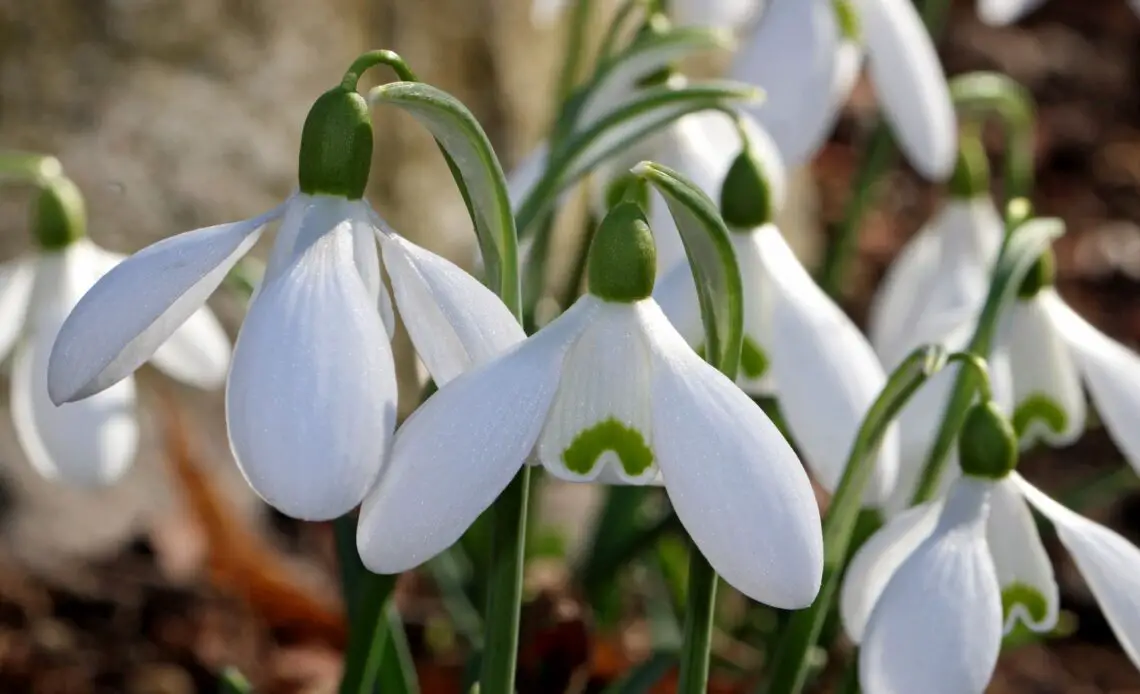
Last updated on May 22nd, 2023 at 10:23 am
Snowdrop (Galanthus nivalis) is a botanical genus of nearly 20 species of plants in the family Amaryllidaceae. The drooping flowers are small, white, and bell-shaped, with green markings on the inner petals. The two leaves are basal, linear, and strap-shaped and resemble blades of grass.
In many climates, snowdrops are the first flowers to appear in the spring. They can often be seen blooming amid a snow cover. Snowdrops have a wide geographical distribution, from Europe to Iran and the Caspian Sea. This seemingly tender flower is, in fact, very hardy. Thus, a common snowdrop flower means strength, fortitude, and hope.
The genus, Galanthus, is of Ancient Greek origin, and it comes from the gala, meaning “milk,” and anthos, meaning flower —an obvious reference to its color. The Latin epithet nivalis means “of the snow.” Carl Linnaeus fully translated the flower’s scientific name: “milk flower of the snow.”
The flower’s common name, snowdrop, is derived from the German word Schnee Tropfen, meaning snow-drop. The “drop” part of the name refers not to snow but to the long, tear-shaped pendants and earrings (drops) women wore in the sixteenth and seventeenth centuries. These “drop” earrings can be seen in many Dutch and Italian paintings of that period.
This flower is also known under other descriptive names, including Foolish Maids, Candlemas Bells, Church Flower, Dingle-Dangle, Fair Maid of February, Mary’s Tapers, Winter Gilliflower, and SnowPiercer.
What Does The Snowdrop Flower Symbolize?
The snowdrop flower has been named the “Fair Maid of February” and is associated with February 2. In Christianity, this is the day of the Purification of the Virgin. The story goes that the Virgin Mary’s image was removed from the altar that day, and snowdrop flowers appeared. It is also said that the delicate snowdrop blossoms resemble the maidens who, dressed in white, walked in procession at the Feast of Purification.
Another Christian story goes that on February 2, known as Candlemas Day—mother Mary took her child Jesus to the Jewish Temple. There, she presented an offering of a lamb and a pigeon, symbolizing purity. On that occasion, chaste snowdrops sprung from her footprints. For this reason, the snowdrop is also known as the Candlemas Bells flower.
Due to its immaculate whiteness, the snowdrop flower is also associated with purity and virginity. Snowdrops were often found in the gardens and orchards of monastic communities.
The legend goes that after the fall of Adam and Eve and their banishment from the Garden of Eden, snow began to fall. As a result, the earth became completely barren. Flowers could bloom no more. Seeing this, Eve felt even more lonely and despondent and began to mourn. The angel saw her sorry and went to console her. The angel caught a snowflake in the air, breathed into it, and commanded it to assume a form.
The snowflake became a lovely snowdrop flower as soon as it fell onto the ground. In awe at what she had just witnessed, Eve finally smiled and considered it more precious than any other flower in Paradise. The angel, too, assured Eve that the arrival of this flower was a messenger of the forthcoming sun and summer. Based on this story, one of the strongest snowdrop flower meanings became consolation, hope, and rebirth.
Some snowdrop flower meaning is derived from an old German folktale. The story goes that long ago, at the beginning of time, the snow needed to find its color. It sought a suitable color among the beautiful flowers. But all the flowers jealously guarded their colors and refused to help the snow.
The main reason for their unfriendly behavior was their belief that snow was cold and brought discomfort. The snowdrops were the only flower kind enough to offer their color to the Show. As a result, the snow became white. To repay for the kindness of the lovely little snowdrops, the snow protected them from cold and ice. Thus, it is said the snow and the snowdrops remain friends, always sitting side by side.
A Moldovan story tells of an almost mythical battle between the Winter Witch and Lady Spring. In that battle, the Spring ferociously opposed Winter and got wounded. From the spilled blood of the heroic Spring, snowdrop flowers sprouted and bloomed. Therefore, another snowdrop flower meaning is that of braveness and strength.
The snowdrop flower did not always have a reputation as a pure, protective, and encouraging flower.
According to an old folk belief from England, bringing the first snowdrop indoors was once considered unlucky. Such a flower was regarded as a death token, as some believed it resembled a corpse in its shroud. Another reason for associating snowdrops with death was the flower’s short stem and downward orientation. People used to say that the snowdrop flower always kept itself close to the earth, belonging more to the dead than the living.
A more extreme version of this superstition goes that a mere sight of a single snowdrop flower growing in one’s garden is a bad omen that announces a forthcoming disaster. Bringing snowdrop flowers as a gift to a patient in a hospital was forbidden; such an act was considered a death sentence. For this reason, in Somerset, snowdrops were also called Death’s Flower.
In Wales, it was believed that snowdrops plucked on St. Valentine’s Day and being taken indoors could cause a family member’s death and spoil the cow’s milk. There were, however, certain exceptions to this dreadful rule. For example, it was believed that only cut snowdrops were unlucky and snowdrops grown in pots were safe to bring into the house.
According to an old belief from lowland Scotland, the person who finds a snowdrop flower before January 1 would be exceptionally lucky throughout the year.
All in all, the snowdrop flower symbolic meanings are:
- new beginnings
- hope
- rebirth
- renewal
- consolation
- the ability to overcome challenges
- purity
- fertility
Meaning Of The Snowdrop Flower Color
White color
All snowdrop flowers are white. Therefore, there is no color-specific symbolism attributed to these flowers.
In the symbolic language of flowers, the white snowdrop flower’s meaning includes purity, hope (especially hope in sorrow), consolation, a friend in need, and a friend in adversity.
Interesting Facts About The Snowdrop Flowers
- In European traditional medicine, an ointment made of crushed bulbs of snowdrop flowers was used to treat frostbite, chilblains, and glaucoma.
- Modern medicine uses snowdrops in the treatment of Alzheimer’s disease.
- The Danish writer Hans Christian Andersen has recorded a folktale named “The Snowdrop.” A girl sends a snowdrop flower to her short-term boyfriend, making a “summer fool” of him, for she is determined to find a new boyfriend by midsummer.
- Snowdrops are native to Europe and the Middle East.
- The snowdrops are poisonous to humans and can be fatal.
- The snowdrops have a status of endangered species in several countries, and their International trade is banned.
- There is a special name for collectors of snowdrop varieties—they are called Galanthophiles.
How To Grow Snowdrop Flowers
Snowdrop flowers require little care and can be cultivated in the soil of any pH level. They can fill in shaded areas where many groundcovers cannot grow.
- Plant the snowdrop in loose, well-drained soil with plenty of humus.
- Place the plant where it can get 6 or more hours of direct sunlight daily.
- Water the plant in warmer climates.
- Apply a bulb fertilizer at planting time to help boost your snowdrops to a good start.
How To Care For Snowdrop Flowers
- Water the snowdrops only when the soil dries out during prolonged dry periods.
- Give the plant a light feed with a granular general fertilizer after flowering.
- Allow the foliage to die down naturally in spring.
Best Time To Gift Snowdrop Flowers
The diverse symbolism and folklore related to the snowdrop flower make it a unique gift. A handful of snowdrop flowers can be gifted to a close friend in times of sorrow and adversity as a symbol of encouragement, support, and hope.
Spiritually inclined family members and friends will appreciate the gift of snowdrop flowers, as they symbolize the purity of the soul.
Above all, being harbingers of the spring, snowdrop flowers will bring happiness and smiles to everyone who receives them.
Conclusion
The snowdrop flower, beloved for its delicate beauty, has long been a sign that winter is ending. But it is only one of its interpretations. Snowdrop flowers have cultural significance ranging from humility and purity to sympathy, fertility, and rebirth.
The fragile, lovely snowdrop blossoms complement any floral present with their pure white color and sweet fragrance since they are often the first to emerge from the snow in late winter or spring.
If you want to know and learn more about flowers, we at PansyMaiden can help you. Check out our fun, easy-to-read, and informative flower-related content that you will surely enjoy!
